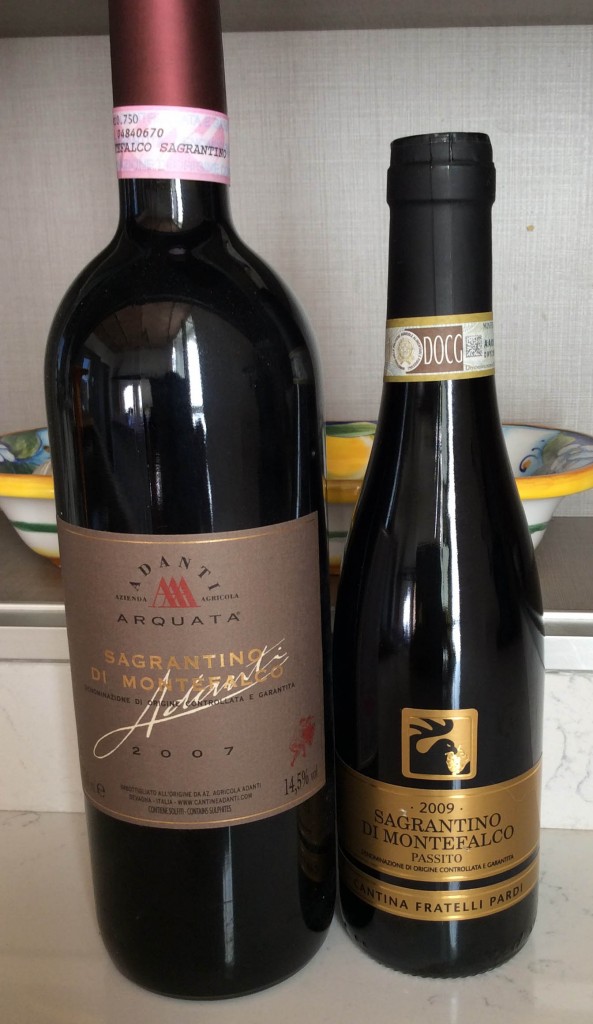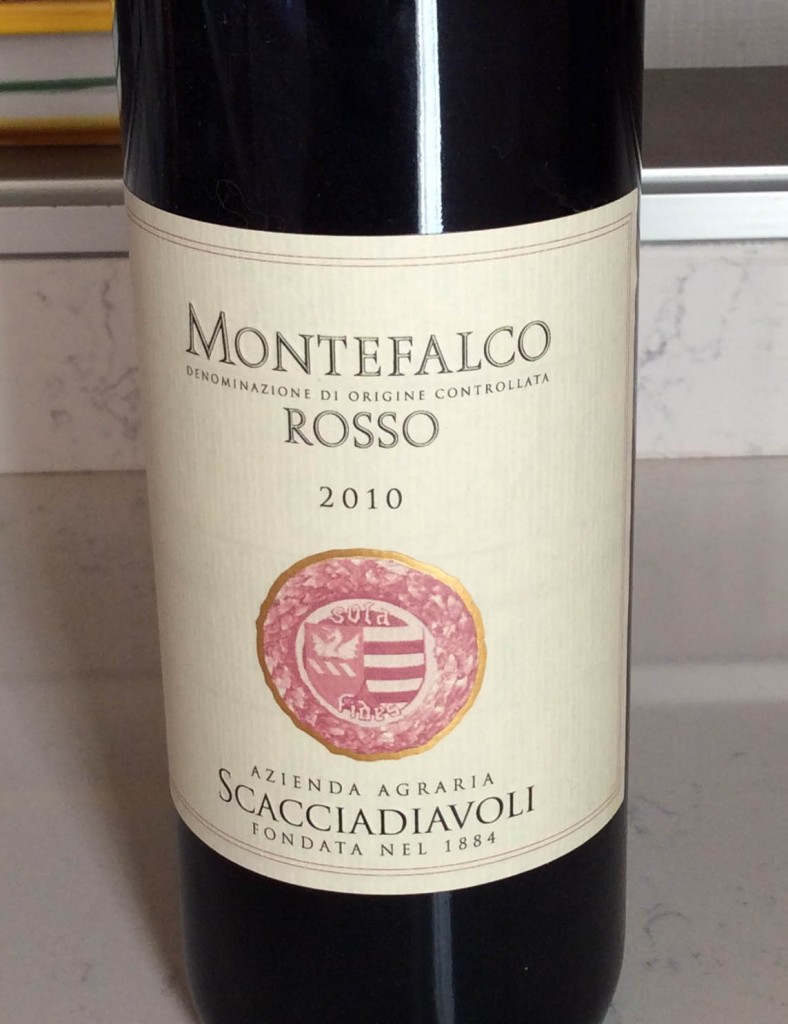Another guest post from Luther the Wine Guy. WOW that was fast!
Whoops! I got sidetracked with all that DOC stuff and forgot to talk about the Umbrian red grapes, so let’s do that now…
Umbrian Grapes Redux
Sagrantino is Umbria’s gift to the red wine world. It is a monster, being considered one of the most tannic grapes in the world. Its production is extremely limited, as there are only about 100 hectares (about 240 acres) in the entire area. It produces a dense, dark wine capable of up to 16%(!) alcohol content that requires considerable aging just to get under control. The sagrantino area centers around Montefalco and Bevana, reaching southwest to Todi northwest to Perugia.
Sagrantino has been cultivated for hundreds of years in and around Montefalco, but was used strictly to make dessert and sacramental wines. (I’m told that “sagrantino” is dialect for sanctified). These wines were made in a style called passito wherein the grapes are not immediately crushed, but are allowed to dry out, increasing the concentration of the juice. This technique, which is similar to those used to make dessert wines in France and other Italian areas, is modified in Umbria in that the wine made is dry or almost nearly so. Wine made in this passito style remains popular in Umbria. I find it a little bit strange. It has the body and appearance of a port, but it lacks the sweetness. Some adventurous producers have experimented with stopping the fermentation process early, leaving a considerable amount of residual sugar. This makes a much more satisfying desert wine, which I would be proud to pour in place of an Late Bottled Vintage port, for example.
Fortunately for us big red wine fans, in the mid-seventies several sagrantino producers started to experiment with making a dry red wine from the grape. Because of the high level of tannin in the juice, the wine that comes out is almost undrinkable at first–think a zinfandel that shrinks your tongue to a sliver from its runaway tannins. But, unlike zinfandel, if you’re willing to age this stuff properly, it is fantastic. The Italian DOC requires that wines labeled “DOCG Sagrantino” be aged for a minimum of 29 months. What comes out in my opinion is still pretty raw. I have tasted these young ones. The fruit is there, but the body lacks substance and the tannins are still screaming away. After another three or four years, things are starting to smooth out and the result is, for me, like a very fine cabernet, but with a touch more fruit and less of that austerity that cabernet frequently exhibits. For those with less patience, most producers also offer a Riserva that undergoes several years additional barrel aging. Be aware though that there is no “Sagrantino Riserva” DOCG and so “Riserva” means whatever the producer says it means–it’s not a well defined turn. Nancy and I have been drinking the 2007 Adanti Sagrantino di Montefalco “Adanti” and it is fantastic. Better still, it’s sold in the USA, so you might be able to find some. Give it a go and let us know. Here is the half bottle of passito and the Adanti next to it.
Although sagrantino is the big dog in the Umbrian kennel, the most ubiquitous red grape in Umbria, indeed in just about all of central Italy, is sangiovese. Most folks know sangiovese from the red wines of Tuscany, some which are exclusively sangiovese (Brunello di Montalcino, the Cadillac of traditional Tuscan winemaking), or the backbone of a blend of wines such as Chianti or Vino Nobile di Monepulciano. In most of Umbria, sangiovese is used to make round, juicy, fruit-forward wines that are a pleasure at a fairly early age. Most sangiovese sees very little barrel aging and is blended with local Umbrian grapes such as canaiolo and colorino, two grapes also used to make Chianti.
Sangiovese comes to the rescue of impatient sagrantino fans who just can’t let those bottles sit around the house that long. It is used to blend out a bit of the blast of young sagrantino and is usually blended about 60% sangiovese and 15% sagrantino with other grapes, primarily merlot to make Montefalco Rosso. There are two DOCs for Montefalco Rosso: the DOC Montefalco Rosso calls for a minimum of 18 months barrel aging, the DOC Montefalco Rosso Riserva requires a minimum of 30 months.
I am a huge fan of Montefalco Rosso. It is a remarkable red with excellent aging potential but without the tannin explosion associated with sagrantino. The Montefalco Rosso DOC is an excellent food wine at a ridculously reasonable price–we usually pay about 8 – 10 Euros a bottle for it ($9 – $11). With 30 months in the bottle, the riserva is a noble wine all by itself. Because I like my wines huge and with some fruit–I am a major zinfandel fan–the sagrantino rates tops for me. But some folks prefer a wine a little more austere and elegant, and the riserva nails this. It is probably Umbria’s best wine value.
There are excellent producers of sangiovese-based wines across Umbria, but the most famous has got to be Lungarotti, based in the town of Torgiano, just a few miles south of Perugia. Lungarotti owns hundreds of acres of vineyards all over Umbria, with by far the major proportion around Torgiano. Lugarotti is huge, producing over 2.5 million bottles a year: almost triple the next major producer. Lungarotti’s sangioveses are considered so good that they have their own DOC, Rubesco di Torgiano and DOCG, Rubesco di Torgiano Riserva. Like the Rosso di Montefalco, the DOC Rubesco is a blend of sangiovese (75%) and the local grapes cannaiolo and colorino I mentioned earlier. It gets a year of barrel aging and another year in the bottle before release. The riserva requires four years in wood and comes exclusively from a single 120 acre property named (oddly enough), Rubesco. (For those trivia followers, Rubesco is an invention based on the latin word rubescare, to blush) I first sampled Rubesco maybe twenty years ago and I have loved it ever since. It used to be very widespread in the states. I could still find it in the Washington DC area if I looked, but it’s not as available as it used to be. Get some: you’ll like it.
All right. That’s enough of the tutorial. In the next segment I’ll talk about some of our field trips.
I hope you all enjoyed the second segment about Umbrian wines. I myself, am looking forward to doing some field testing for future articles!


